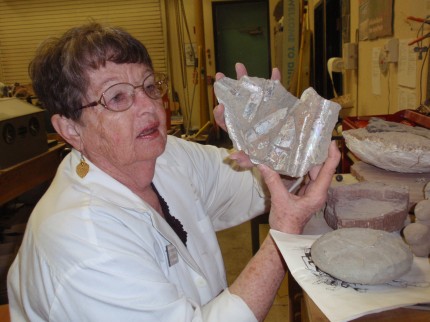Features Reporter, News Editor
Photo by Caleb Ferganchick
Grand Valley residents walked with dinosaurs last Friday as members of Fruita’s Museum of Western Colorado showcased their research lab and collections room.
These areas of the museum can typically only be accessed by museum employees and visiting paleontologists, making the experience as rare as the thousands of brittle bones that adorn the shelves.

Lab supervisor Kay Fredette presents one of the seventeen vertebrae that make up a diplodocus neck at the Museum of Western Colorado dinosaur exhibit Friday.
“We’ve learned to do a lot of weird stuff in here,” lab supervisor Kay Fredette said, leading the attendees into the museum’s research lab.
The lab looked somewhat like a traditional high school shop class, except instead of balsa wood, million-year-old bones were scattered around the tables encased in white plaster.
“I want to point out the overhead garage door,” assistant curator Heidi Schoenstein said. “We absolutely have to have it because some of the material is so huge we can’t get it through the regular door.”
Once casts have passed through the garage door, paleontologists use air drills, an engraving tool that sounds like a dental drill. Fredette explained that they’re actually a percussive hammer, much like a jackhammer, that works to remove the matrix surrounding the bone. A combination of Elmer’s white glue and PaleoBOND superglue hold lightweight fragments together to keep the bones from being damaged.
“There are no special paleotools,” Fredette said. “We use hammers and screwdrivers and chisels and dental picks and paintbrushes.”
Some of these tools could be seen resting on a large plaster jacket that contained crushed dinosaur eggs transported from a quarry near Delta.
“They look just like you peeled a hard boiled egg in your sink,” Fredette said, “except they’re not white. They’re black or really dark brown.”
The museum had recently taken a flattened egg from the same quarry to St. Mary’s Hospital for a CT scan in hopes of discovering embryotic bones. Unfortunately, the results yielded no returns.
Next to the cast, a particularly rare vertebrae from a haplocanthosaurus (the simple spined lizard) rested in a box of fine sand. The bone was discovered near Snow Mass and is one of only five specimens. While the museum is “tickled” to possess it, Fredette explained that there are strict completion requirements for a bone to move onto display, and further identification is still necessary.
“We’d love to put everything on display,” Fredette said. “But it needs to also illustrate something we haven’t demonstrated before.”
The completion process can be incredibly tedious, as a jigsaw-like display of diplodocus (the double beam lizard) vertebrae resting in a large sandbox demonstrated. The bones have been unpacked, polished and pieced together by a museum volunteer for over two years now, and there are an estimated half-dozen pieces still missing.
Once bones are cleaned and polished, they’re transferred across the museum to the collections room, but before entering, the group took a detour to view the rarest collection on display.
In an illuminated box near the front of the museum, pieces of a ceratosaurus (horned lizard) are carefully organized for display. The crest adorning its nose and the particularly large teeth that seem at odds with the rest of the dinosaur’s proportions distinguish the carnivore. The bones were discovered in 2000, and so far Fruita is the only known area to have discovered the dinosaur’s remains. Scientists from all over the world travel to the museum for a chance to study the rare specimen, even as recently as last week.
“I’m showing you this because we have some ceratosaurus bones in the collections rooms, but they’re not much to look at,” Schoenstein said. “A lot of what we have in the collections room are useful for study.”
The collections room, according to Schoenstein, is the core of the museum.
“We’re in the top one percent of museums,” Schoenstein said.
Thousands of bones are systematically cataloged on large shelves or stored in cabinet drawers according to location, date, collector, formation, age, species, body part, and ownership.
The shelves are overwhelmingly stocked with apatosaurus (the deceptive lizard) and allosaurus (the different lizard) bones, which the museum is well known for. Some apatosaurus fossils have deep scratch marks on their surface, indicating the predatory habits of the allosaurus. Unique fossils of crickets, sea crustaceans, ice age mammals, and teeth are also scattered throughout the room amounting to one of the largest dinosaur collections in the mid-west.
The tour concluded with a general tour of the museums displays, which are open to the public on a regular basis. To learn more about the dinosaurs on display at the Museum of Western Colorado, call (970) 858-7282.
Recent Comments